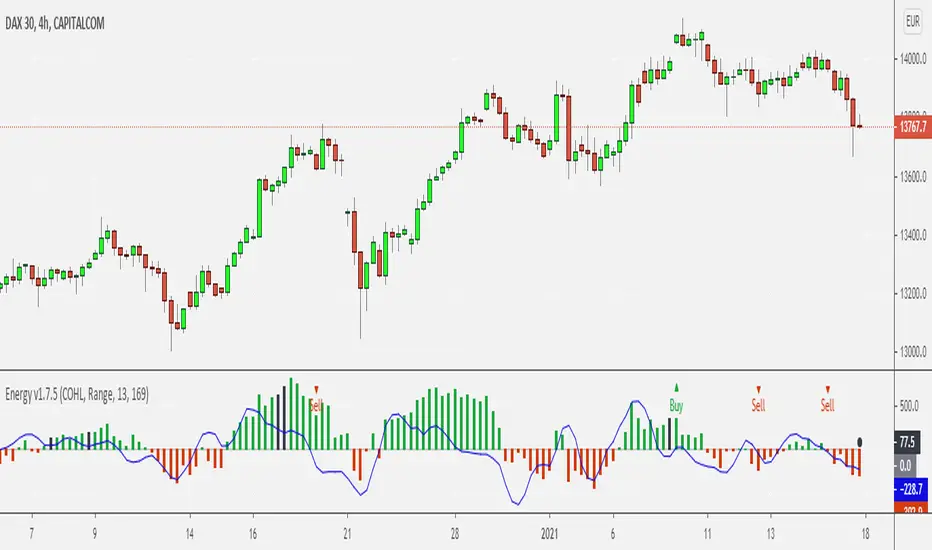PROTECTED SOURCE SCRIPT
Updated Energy v1

Basic energy tracker
Release Notes
Updated to include net energy movementsRelease Notes
Improved modelRelease Notes
Adding new methodology and smoothingRelease Notes
Added a signal line -- crossing the zero line indicates a potential top / bottomRelease Notes
Added new methodologyRelease Notes
Addition of new method - average of High/Low/CloseRelease Notes
This script measures cumulative 'Energy' in a security built up over time where bulls add to the cumulative energy and bears reduce it. Changes to this cumulative energy result from the battle between bulls and bears and can give indications on major turning points as well as signals as to when to enter into a long or short trade. This indicator must be used in conjunction with other techniques.OUTPUTS:
Area chart: longer term cumulative energy model
Histogram: primary energy model where green positive bars indicate positive energy through the lookback period and red is negative
Line chart: signal line used to identify entry and exit points
INPUTS:
Source Data: Data series to use for calculation of energy changes (O=Open, H=High, L=Low, C=Close). Default O/H|L is best for most markets, but some highly trending or volatile markets may require a different methodology. User should experiment with a security and choose based on its effectiveness in the history
Methodology: Moving average or range based calculations through the lookback period.
Volume Weighted: Not usually significant but can be useful adjustment for securities with low liquidity levels
Show MA energy: Display alternative longer term methodology
USAGE:
Blue signal line is the most important indicator and changes from positive to negative or vice versa indicate potential entry and exit opportunities. Users should beware of divergence between the signal line and the energy pattern (histogram) for potential false positive signals.
For example when entering a long position, a good signal is when:
(1) signal line is crossing the zero from negative to positive
(2) energy has been rising consistently for past 3 candles
(3) energy moves into positive at the same time as signal line crosses
(4) longer term energy is increasing (area chart)
Users should avoid using this indicator for entry/exit decisions where there is an absense of a clear trend
User should also take caution where major peaks in long term energy occur which often indicate a period of sideways price movement and increased price volatility. This can be used as part of an options trading strategy but the author has not tested (next version!)
Release Notes
Addition of a buy/sell indicator so that the user can check for potential turning points / direction changes in the market. The indicator should not be used in isolation but rather should be confirmed using other methodologies. Potential long position entries are indicated with a green 'Buy' and a potential short position with a red 'Sell'. NOTE: the indicators are designed to show ENTRY positions only. Exits and stop losses are not included in this version.
Release Notes
Improved algorithm for identifying Buy and Sell signals for further analysis. No other changes in this version v1.7.1Release Notes
1. Addition of new COHL methodology for energy calculation which is useful for high volatility securities2. Addition of checks for divergences in energy changes, with bars shown in black. Users should be cautious that the market may change direction (or reverse) on or near to a divergence candle
Release Notes
Added Alert Condition with a title of "Buy/Sell Signal" so that the indicator can be used with the Tradingview Alerts.Release Notes
Added a long term weighted average cumulative energy indicator that is shown on the last bar only. This indicator shows the user whether long term investors are still overall bullish or bearish and by how much and also forms a target for mean reversionProtected script
This script is published as closed-source. However, you can use it freely and without any limitations – learn more here.
Disclaimer
The information and publications are not meant to be, and do not constitute, financial, investment, trading, or other types of advice or recommendations supplied or endorsed by TradingView. Read more in the Terms of Use.
Protected script
This script is published as closed-source. However, you can use it freely and without any limitations – learn more here.
Disclaimer
The information and publications are not meant to be, and do not constitute, financial, investment, trading, or other types of advice or recommendations supplied or endorsed by TradingView. Read more in the Terms of Use.